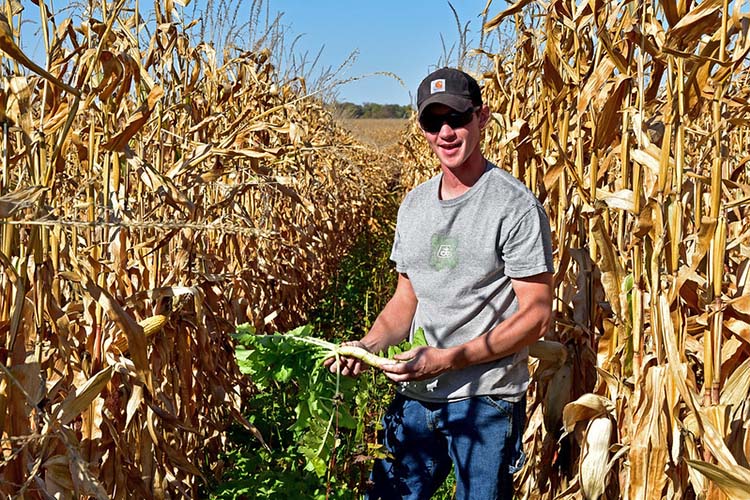Summer interseeding may be a good cover crop strategy for farmers with shorter growing seasons. So say the first-year results from a USDA-sponsored soil health demonstration project in northern Iowa. Interseeding allows cover crops to grow and take root prior to corn canopy. After canopy, the cover crop goes dormant from being shaded out then regrows after the corn harvest.
Fifteen producers who struggled for years to consistently establish fall-seeded cover crops are working with the USDA Natural Resources Conservation Service to interseed cover crops at the V4-V7 corn growth stage, which typically occurs in June in northern Iowa. USDA awarded the Allamakee Soil and Water Conservation District a three-year, $236,000 Conservation Innovation Grant to lead, manage, and analyze a series of field-based trials.

The On-Farm Conservation Innovation Trials were authorized as a part of the Conservation Innovation Grants program in the 2018 Farm Bill. They feature collaboration between NRCS and partners to implement on-the-ground conservation activities and evaluate their impact. Incentive payments help producers offset the risk of implementing innovative approaches.
Why grow cover crops?
Cover crops help reduce soil erosion, utilize excess soil nutrients, suppress weeds, minimize soil compaction, increase soil organic matter, and improve soil moisture efficiency and overall soil health. In addition to the environmental and soil health benefits, some cover crops are good grazing forage for livestock and wildlife.
Demonstration Details
In the northern Iowa trials, most participants planted four interseeded 30-inch corn row plots and four control 30-inch corn row plots. Each plot was at least the width of a combine and at least 300 feet long.
Producers interseeded cover crops when corn was at the V4-V7 growth stage, choosing from four different seed mixes that included ryegrass, buckwheat, brassicas, and cow peas. They used various cover crop seeding methods, including no-till, broadcast spreader, Monosem planter, and custom air seeders.
Two participants also interseeded 60-inch corn rows through the trial. Brady Kruger, of Waukon, Iowa, planted his 60-inch twin rows at the same population as his 30-inch rows. He said the growth difference was substantial. “I really enjoyed walking the (60-inch) plot throughout the summer and seeing the difference and how cover crop species performed much better when given more sunlight,” said Kruger. “The (corn) yield came out to be the same as the rest of the farm, so I was pleased with that, considering how dry August was.”
Aarik Deering, of Postville, Iowa, discovered the interseeded cover crops didn’t rob moisture from corn during grain fill. “I am planning more 60-inch twin row corn for 2021 and will be putting a lot more effort into it,” he said. “I feel there is great potential there.”
Cover crop biomass samples taken between the 60-inch corn rows outperformed the 30-inch rows by an average 3,400 pounds. That increased biomass will provide better weed control, more nitrogen fixation, and additional winter forage for cattle.
Analyzing Year 1 Results
Farmers completed at least four replicated strip trials at each demonstration site. Project coordinator Eric Novey is working with participants to collect data. He evaluates yields, crop biomass, nutrient uptake, soil microbiology, soil loss, soil temperature, and several soil health measures using the Haney Test, which allows the producer to evaluate overall soil health.
A sampling of Year 1 results:
- Corn Yields – Plots interseeded with cover crops yielded slightly better than plots with no cover crops (188 bushels per acre compared with 187). Ten of the 15 participants produced better corn yields in fields with cover crops.
- Cover Crop Biomass – Novey measured biomass in July, August, and September. Data showed a sharp increase in biomass from July to August (400 lbs./acre to 525 lbs./acre) and a slower rate of increase from August to September (550 lbs./acre).
- Soil Temperatures – Cover crops kept soil temps more consistent during the growing season. “The seeded strips were slightly cooler in the summer, but what was more noticeable was the seeded strips had fewer extremes in temperature,” Novey said.
The trials revealed not all seeding methods provided equal results. “Farmers who opted to broadcast the cover crop seemed less satisfied,” he said. “They had issues with growth consistency and overall delayed growth, leading to less biomass.”
Conservation Innovation Grants (CIG) is a competitive program that supports the development of new tools, approaches, practices, and technologies to further natural resource conservation on private lands. Through creative problem solving and innovation, CIG partners work to address our nation’s water quality, air quality, soil health and wildlife habitat challenges, all while improving agricultural operations. For more information, visit the CIG website.
Jason Johnson is a public affairs specialist with NRCS in Des Moines, Iowa. He can be reached at Jason.r.johnson@usda.gov.


